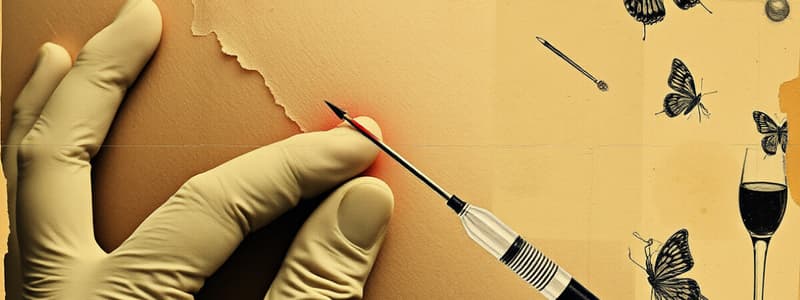Podcast
Questions and Answers
What is the maximum puncture depth for capillary blood collection in adults and children?
What is the maximum puncture depth for capillary blood collection in adults and children?
- 2.4mm
- 2.0mm
- 3.0mm (correct)
- 1.6mm
Which of the following is NOT a suitable site for capillary puncture?
Which of the following is NOT a suitable site for capillary puncture?
- Surface of the palm
- Thumb (correct)
- Plantar surface of the heel
- Lateral side of the foot
Which collection site is appropriate for performing a skin puncture on an infant under 6 months of age?
Which collection site is appropriate for performing a skin puncture on an infant under 6 months of age?
- Palmar surface of the wrist
- Margin of the earlobe
- Plantar surface of the heel (correct)
- Palmar surface of the middle finger
Why is it important to wipe away the first drop of blood during specimen collection?
Why is it important to wipe away the first drop of blood during specimen collection?
What should be used to clean the skin puncture site prior to the procedure?
What should be used to clean the skin puncture site prior to the procedure?
What should be done immediately after collecting the blood specimen?
What should be done immediately after collecting the blood specimen?
What is the maximum depth for a heel puncture in infants to avoid risks?
What is the maximum depth for a heel puncture in infants to avoid risks?
Why should the first drop of blood be wiped away during a skin puncture?
Why should the first drop of blood be wiped away during a skin puncture?
Which of the following is the correct order for preparing the puncture site?
Which of the following is the correct order for preparing the puncture site?
What is the primary purpose of using a warmer or warm washcloth on the puncture site?
What is the primary purpose of using a warmer or warm washcloth on the puncture site?
Which statement about warming the skin puncture site is correct?
Which statement about warming the skin puncture site is correct?
What precaution should be taken regarding latex when preparing for blood collection?
What precaution should be taken regarding latex when preparing for blood collection?
What type of microcollection tube should be filled first to ensure accurate hematology results?
What type of microcollection tube should be filled first to ensure accurate hematology results?
What is the mnemonic used to remember suitable puncture sites?
What is the mnemonic used to remember suitable puncture sites?
What type of lancets are recommended for skin puncture procedures?
What type of lancets are recommended for skin puncture procedures?
Which of the following patients is most likely to benefit from a skin puncture procedure?
Which of the following patients is most likely to benefit from a skin puncture procedure?
Study Notes
Skin Puncture (Capillary or Dermal Puncture)
- Utilized for micro sampling, particularly appropriate for infants, young children, adults with poor veins, and elderly patients with fragile veins.
- Common collection sites include the earlobe margin, palmar surface of fingers, and plantar surface of the heel.
- Specific heel puncture techniques for infants under 1 year involve lateral or medial plantar surfaces.
Collection Techniques
- For children over 1 year and adults, use the palmar surface of the 3rd (middle) or 4th (ring) finger on the nondominant hand.
- Punctures should be perpendicular to fingerprint lines to ensure proper blood flow.
- Avoid puncturing infants' fingers to prevent serious bone injury.
- Warming the puncture site can increase blood flow up to sevenfold; methods include massage or application of a commercial warmer.
Site Preparation
- Clean the puncture site with 70% isopropyl alcohol and allow it to air dry; povidone-iodine should not be used due to contamination risks.
- First drop of blood should be wiped away to prevent tissue fluid contamination.
Procedure Essentials
- Efficient method for obtaining small blood volumes via puncturing the capillary bed with a sterile, sharp blade.
- Securely immobilize the finger or heel before puncturing.
- Recommended puncture depth for infants is no more than 2mm to prevent potential complications.
Equipment Used
- Sterile Lancets/Blades: Must be single-use and include retractable blades to pierce skin effectively.
- Capillary Tubes: Come in various sizes, with heparin options; distinct color codes for anticoagulants.
- Microcollection Tubes: Different order of draw compared to evacuated tubes; prioritize filling EDTA tubes for hematology tests.
Recommended Procedure Steps
- Examine requisition form and assemble necessary equipment.
- Ensure proper patient identification and confirm dietary or medical restrictions.
- Position patient correctly, don gloves, and organize materials.
- Explain procedure, select and warm the puncture site, and clean with isopropyl alcohol.
- Perform the puncture, ensuring not to exceed prescribed depth, and collect specimen while mixing as needed.
- Label specimens accurately and manage disposal of equipment responsibly.
Specimen Rejection Criteria
- Be aware of inappropriate puncture sites, such as the thumb, index finger, and pinky, due to risk factors like callus thickness and proximity to bone.
Additional Notes
- Use the mnemonic "Make Little People Happy" for remembering suitable puncture sites: Median, Lateral, Plantar, Heel.
- Recommended puncture depths: 2.4mm - 3mm for children and adults, 1.6mm - 2.0mm for infants, and 0.65mm - 0.85mm for premature infants.
Studying That Suits You
Use AI to generate personalized quizzes and flashcards to suit your learning preferences.
Description
This quiz focuses on the essential techniques of specimen collection through skin puncture, specifically capillary or dermal puncture. It covers collection methods for various age groups, including infants, young children, and elderly patients with challenging vein access. Test your knowledge on the appropriate sites and procedures related to micro sampling in clinical practice.




